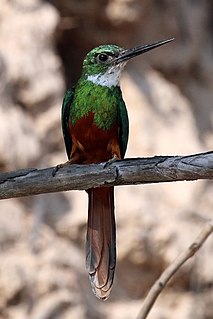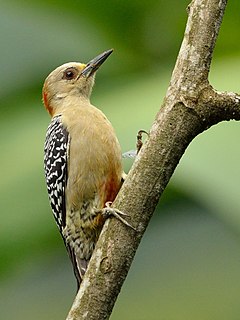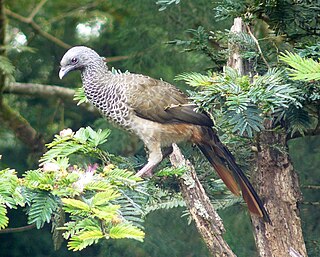
The chachalacas, guans and curassows are birds in the family Cracidae. These are species of tropical and subtropical Central and South America. The range of one species, the plain chachalaca, just reaches southernmost parts of Texas in the United States. Two species, the Trinidad piping guan and the rufous-vented chachalaca occur on the islands of Trinidad and Tobago respectively.

The rufous-tailed jacamar is a near-passerine bird which breeds in the tropical New World in southern Mexico, Central America and South America as far south as southern Brazil and Ecuador.

The bearded bellbird also known as the campanero or anvil-bird, is a passerine bird which occurs in northern South America. The male is about 28 cm (11 in) long with white plumage apart from a brown head and black wings. At his throat hang several black, unfeathered wattles. The female is a little smaller with olive-green head and upper parts, yellow underparts streaked with green and a yellow vent area. The male has a loud, repeated metallic hammering call, as well as various other vocalisations.

The rufous-breasted wren is a small songbird of the family Troglodytidae. It is found in Colombia, Costa Rica, Panama, Trinidad and Tobago, and Venezuela.

The rufous-breasted hermit or hairy hermit is a hummingbird that breeds from Panama south to Bolivia, and on Trinidad, Tobago and Grenada. It is a widespread and generally common species, though local populations may change in numbers and disappear altogether in marginal habitat.

The green kingfisher is a resident breeding bird which occurs from southern Texas in the United States south through Central and South America to central Argentina.

The red-crowned woodpecker is a resident breeding bird from southwestern Costa Rica, Panama, Colombia, Venezuela, the Guianas and Tobago.

The grey-headed chachalaca is a member of an ancient group of birds of the family Cracidae, which includes chachalacas, guans, and curassows. It is found from Honduras to Colombia.

The white-bearded manakin is a small passerine bird which breeds in tropical South America. It is found from Colombia, Venezuela and Trinidad south to Bolivia and northern Argentina. This manakin is found in forests, secondary growth and plantations. It is a small, plump bird about 10.7 centimetres (4.2 in) long. Males have a black crown, upper back, wings and tail and are otherwise white. Females are olive-green and resemble female golden-headed manakins. At breeding time, males are involved in lekking behaviour on the forest floor during which they puff out their neck feathers. This is a fairly common species with a wide range, and the International Union for Conservation of Nature has rated its conservation status as being of "least concern".

The ruddy ground dove is a small New World tropical dove. It is a resident breeder from Mexico south to Brazil, Peru and Paraguay, and northern Argentina, and on Trinidad and Tobago. Individual birds can sometimes be seen in the southwestern USA, from southern Texas to southernmost California, primarily during winter.

The plain chachalaca is a large bird in the chachalaca, guan and curassow family Cracidae. It breeds in tropical and subtropical environments from mezquital thickets in the Rio Grande Valley in southernmost Texas, United States to northernmost Costa Rica. In Central America, this species occurs in the Pacific lowlands from Chiapas, Mexico to northern Nicaragua and as a separate population in Costa Rica, where its range is separated by a short distance, as a disjunct population.

The rufous-shafted woodstar is a species of hummingbird in tribe Mellisugini of subfamily Trochilinae, the "bee hummingbirds". It is found in Colombia, Trinidad and Tobago, and Venezuela.

The rufous-headed chachalaca is a species of bird in the family Cracidae, the chachalacas, guans, and curassows. It is found in Colombia, Ecuador, and Peru.

The chestnut-winged chachalaca is a species of bird in the family Cracidae, the chachalacas, guans, and curassows. It is endemic to Colombia.

The speckled chachalaca is a species of bird in the family Cracidae, the chachalacas, guans, and curassows. It is found in Bolivia, Brazil, Colombia, Ecuador, and Peru.

The West Mexican chachalaca is a species of bird in the family Cracidae, the chachalacas, guans, and curassows. It is endemic to Mexico.

The rufous-bellied chachalaca is a species of bird in the family Cracidae, the chachalacas, guans, and curassows. It is endemic to western Mexico.

The rufous-tailed flatbill is a species of bird in the family Tyrannidae. It is found in Bolivia, Brazil, Colombia, Ecuador, French Guiana, Guyana, Peru, Suriname, and Venezuela. Its natural habitat is subtropical or tropical moist lowland forests.

The East Brazilian chachalaca is a species of bird in the family Cracidae, the chachalacas, guans, and curassows. It is endemic to eastern Brazil.

The Colombian chachalaca is a species of bird in the family Cracidae. It is endemic to the forests and woodlands in the inter-Andean valleys in Colombia. Colombian Chachalacas are frugivorous and lead an arboreal lifestyle. The large seeds they disperse through defecation support the maintenance of diverse tropical forests.























